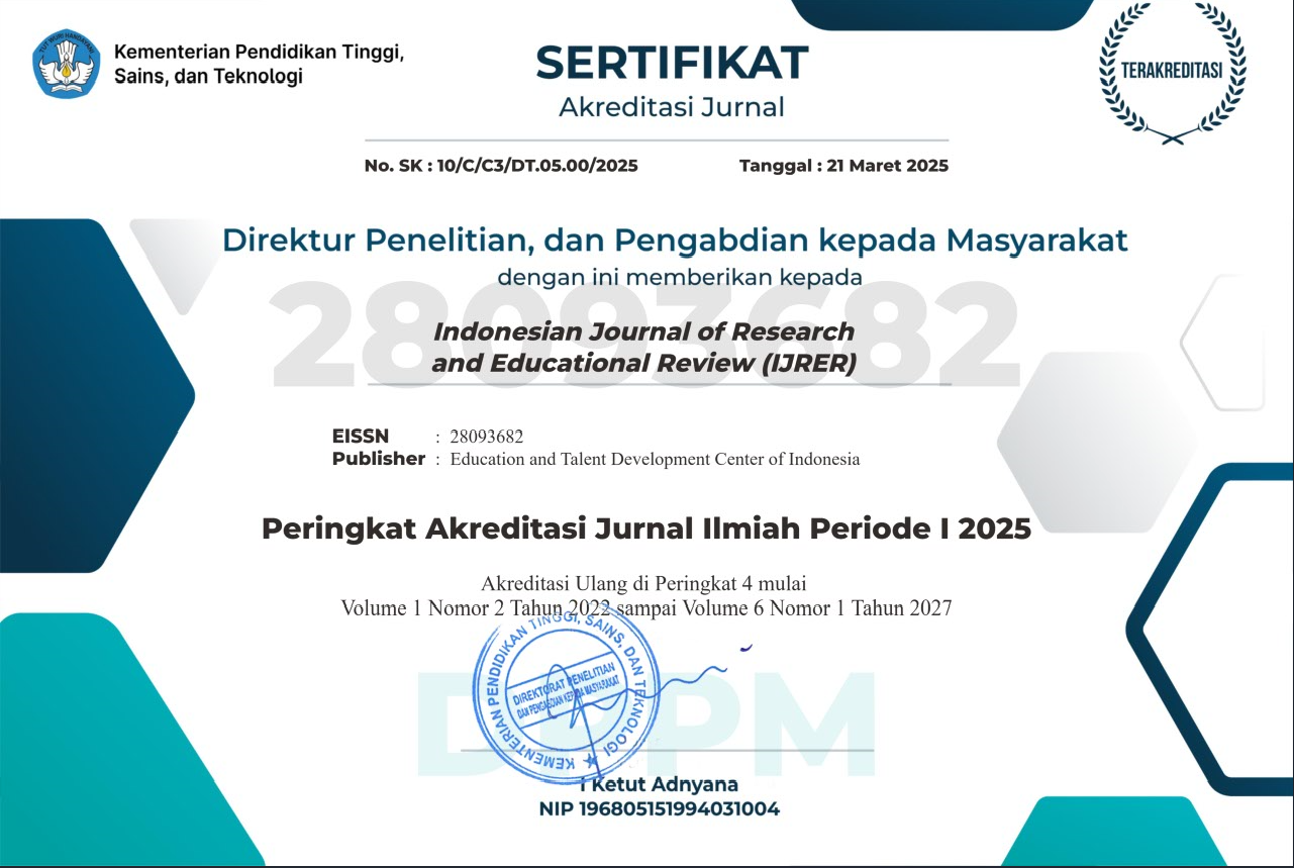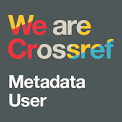The Frayer Learning Model Assisted by Flashcard Media: Descriptive Text Writing Skills of Islamic Elementary School Students
DOI:
https://doi.org/10.51574/ijrer.v4i4.3823Keywords:
Descriptive Text, Flashcard Media, Frayer Learning Model, Islamic Elementary School, Writing SkillsAbstract
The purpose of this study was to describe the effect of the Frayer learning model assisted by flashcard media on descriptive writing skills in Indonesian language subjects for elementary school students. This research employs an experimental design with a nonequivalent control group. This study was conducted in Grade 2 at Islamic Elementary School Assalam Bandar Lampung. Data collection was done using observation sheets and tests. Data analysis used quantitative analysis with an independent t-test. The findings indicated that the Frayer learning model, facilitated by flashcard media, significantly and positively influenced the descriptive text writing abilities of second-grade students. The hypothesis test results, derived from an independent samples t-test, demonstrated a significance (2-tailed) value of 0.000, which is less than 0.05 (0.000 < 0.05), leading to the rejection of H₀ and the acceptance of H₁. Moreover, a substantial disparity in learning outcomes was observed between the experimental group and the control group. The experimental group employing the Frayer model achieved an average posttest score of 44.80, which was significantly superior to the control group's average posttest score of 38.70, utilizing the discovery learning method and video media. Moreover, the implementation of the Frayer learning model utilizing flashcards not only enhanced the average proficiency of students but also yielded more uniform and consistent capabilities. This data suggests that this model effectively aids most students, irrespective of their initial abilities, in attaining improved learning outcomes.
References
Alashry, S. A. A. N., Qoura, A. A. S., & Gohar, R. H. A. A. (2019). The Impact of Frayer Model and contextual redefinition strategy on Improving preparatory stage pupils' vocabulary learning. Journal of Research in Curriculum Instruction and Educational Technology, 4(4), 11-36. https://jrciet.journals.ekb.eg/article_31954.html
Aprelia, D. A., Baedowi, S., & Mudzantun, M. (2019). Pengaruh Pendekatan Kontekstual Dalam Meningkatkan Keterampilan Menulis Narasi. Mimbar PGSD Undiksha, 7(3). https://doi.org/10.23887/jjpgsd.v7i3.19400
Asyifa, N., Azizah, P., & Tania, V. (2024). Keterampilan menulis teks deskripsi dalam pembelajaran bahasa Indonesia sekolah dasar. Semantik: Jurnal Riset Ilmu Pendidikan, Bahasa dan Budaya, 2(3), 244-252. https://doi.org/10.61132/semantik.v2i3.851
Baehaki, I., & Cahyani, I. (2016). Peningkatan keterampilan menulis deskripsi dengan teknik rumpang melalui media gambar. EduHumaniora| Jurnal Pendidikan Dasar Kampus Cibiru, 7(2), 164-172. https://ejournal.upi.edu/index.php/eduhumaniora/article/view/2707
Bizami, N. A., Tasir, Z., & Kew, S. N. (2023). Innovative pedagogical principles and technological tools capabilities for immersive blended learning: a systematic literature review. Education and Information Technologies, 28(2), 1373-1425. https://doi.org/10.1007/s10639-022-11243-w
Chandra, C., & Kharisma, I. (2025). Analisis Kesulitan Menulis Karangan Deskripsi di Kalangan Siswa Fase C Sekolah Dasar. Pragmatik: Jurnal Rumpun Ilmu Bahasa dan Pendidikan, 3(3), 132-143.
Daulay, S. H., Damanik, E. S. D., & Annisa, N. (2023). Student’s difficulties on writing descriptive text. EJI (English Journal of Indragiri): Studies in Education, Literature, and Linguistics, 7(1), 54-66.
Dazzeo, R., & Rao, K. (2020). Digital Frayer model: Supporting vocabulary acquisition with technology and UDL. TEACHING Exceptional Children, 53(1), 34-42. https://doi.org/10.1177/0040059920911951
Fitrianingsih, R. A., Suaedi, H., & Vardani, E. N. A. (2024). Descriptive Text Writing Skills Through Picture Media in Elementary School Students. Edunesia: Jurnal Ilmiah Pendidikan, 5(1), 185-204. https://doi.org/10.51276/edu.v5i1.568
Gultom, F. Y., & Mudiono, A. (2024). Penggunaan flashcard untuk meningkatkan keterampilan literasi pada siswa kelas 1 sekolah dasar. Journal of Language, Literature, and Arts, 4(3), 288-294.
Hasan, K. K., & Daham, H. S. (2021). The Impact of Frayer Model Strategy on EFL Pupils’ Achievement. Journal of Language Studies, 4(4), 520-562. https://doi.org/10.25130/jls.4.4.26
Hoerudin, C. W. (2022). Upaya Guru Meningkatkan Motivasi Belajar Siswa Pada Pembelajaran Bahasa Indonesia. Jurnal Al-Amar: Ekonomi Syariah, Perbankan Syariah, Agama Islam, Manajemen Dan Pendidikan, 3(1), 32-41.
Hoerudin, C. W. (2023). Penerapan media flash card pada mata pelajaran Bahasa Indonesia sebagai upaya meningkatkan kemampuan membaca siswa. Jurnal Primary Edu, 1(2), 235-245. http://jurnal.rakeyansantang.ac.id/index.php/primary/article/view/403
Hoerudin, C. W. (2024). Upaya Meningkatkan Kemampuan Membaca Siswa Dengan Menggunakan Media Flash Card Pada Mata Pelajaran Bahasa Indonesia Di Sekolah Dasar. Jurnal Ilmu Pendidikan (ILPEN), 3(1), 1-15. https://doi.org/10.3709/ilpen.v3i1.37
Husna, L. (2017). An analysis of students’ writing skill in descriptive text at grade X1 IPA 1 of MAN 2 Padang. Jurnal Ilmiah Pendidikan Scholastic, 1(1), 16-28.
Ismayanti, E., & Kholiq, A. (2020). An analysis of students’ difficulties in writing descriptive text. E-link Journal, 7(1), 10-20. https://doi.org/10.30736/ej.v7i1.260
Ispandi, S. N., Suryana, D., & Chandra, D. (2025). Analisis kesulitan menulis karangan sederhana pada peserta didik kelas V di SDN Sukamenak Indah. COLLASE (Creative of Learning Students Elementary Education), 8(1), 143-160. https://doi.org/10.22460/collase.v8i1.22725
Iswara, D. M. (2024). Metode pembelajaran yang sesuai untuk peserta didik. Karimah Tauhid, 3(5), 5984-6013.
Kandia, I. W., Suarningsih, N. M., Wahdah, W., Arifin, A., Jenuri, J., & Suwarma, D. M. (2023). The strategic role of learning media in optimizing student learning outcomes. Journal of Education Research, 4(2), 508-514. https://doi.org/10.37985/jer.v4i2.193
Kusumayanthi, S., & Malik, A. A. (2022). The use of mind mapping technique in teaching writing descriptive text. JELA (Journal of English Language Teaching, Literature and Applied Linguistics), 4(1), 34-45.
Mailani, O., Nuraeni, I., Syakila, S. A., & Lazuardi, J. (2022). Bahasa sebagai alat komunikasi dalam kehidupan manusia. Kampret Journal, 1(2), 1-10. https://www.plus62.isha.or.id/index.php/kampret/article/view/8
Mailida, Y., & Wandani, R. R. (2023). Karakteristik mata pelajaran bahasa Indonesia. Innovative: Journal Of Social Science Research, 3(2), 5608-5615. http://j-innovative.org/index.php/Innovative/article/view/900
Panjaitan, N. B., & Sihotang, H. M. (2020). A comparative study between Frayer model and concept mapping strategy to enhance students’ vocabulary acquisition. Acuity: Journal of English Language Pedagogy, Literature and Culture, 5(1), 39-66. https://doi.org/10.35974/acuity.v5i1.2221
Ratminingsih, N. M., Artini, L. P., Santosa, M. H., & Adnyani, L. D. S. (2023). Pembelajaran bahasa Inggris untuk anak abad 21. PT. RajaGrafindo Persada-Rajawali Pers.
Rohmah, H., & Rondli, W. S. (2023). Penerapan Model Pembelajaran Make A Match Berbantuan Media Flash Card Untuk Meningkatkan Keterampilan Membaca Dan Menulis Huruf Jawa Di SD. Didaktik: Jurnal Ilmiah PGSD STKIP Subang, 9(3), 178-188. https://doi.org/10.36989/didaktik.v9i3.1537
Salam, S., Firman, F., & Mirnawati, M. (2022). How to improve learning outcomes of the Indonesian language in elementary schools through the implementation of problem-based learning methods. Pedagogik Journal of Islamic Elementary School, 131-144. https://doi.org/10.24256/pijies.v5i1.2736
Setiadi, G. (2024). Bahasa sebagai simbol peradaban kehidupan manusia dalam berkomunikasi dan bersosialisasi. Asmaraloka: Jurnal Bidang Pendidikan, Linguistik, Dan Sastra Indonesia, 2(1), 1-24. https://www.lp3mzh.id/index.php/asmaraloka/article/view/332
Sya, M. F., Adri, H. T., Kholik, A., Sudjani, D. H., & Lathifah, Z. K. (2021). Indonesian Learning: Towards The Academic Achievement of Communicative Competence. Indonesian Journal of Social Research (IJSR), 3(3), 183-189. https://doi.org/10.30997/ijsr.v3i3.152
Tsabata, M. A. D. (2025). Analisis Penguasaan Kosakata Bahasa Indonesia Siswa Kelas IV melalui Model Frayer di SD Negeri Sidorejo Kabupaten Pekalongan (Doctoral dissertation, UIN KH Abdurrahman Wahid Pekalongan).
Yanti, L., & Depalina, S. (2025). Stimulasi Perkembangan Bahasa Anak Usia Dini melalui Metode Bercerita Interaktif di Lembaga PAUD. Jurnal Pendidikan Bahasa dan Anak Usia Dini, 1(4), 132-141. https://doi.org/10.61132/jupenbaud.v1i4.93
Wahyuni, S. (2020). Penerapan media flash card untuk meningkatkan hasil belajar tema “Kegiatanku”. Jurnal Ilmiah Sekolah Dasar, 4(1), 9-16. https://doi.org/10.23887/jisd.v4i1.23734
Wati, I., & Alimin, A. (2022). The Use of Frayer Model in Teaching Vocabulary at the Tenth Grade Students. Journal of Teaching of English, 7(3), 69-76. https://jte.uho.ac.id/index.php/journal/article/view/59
Wijayanti, T. I., & Utami, R. D. (2022). Mengembangkan Keterampilan Membaca dan Menulis Melalui Berbagai Metode dan Media Pembelajaran yang Bervariasi. Jurnal basicedu, 6(3), 5104-5114. https://doi.org/10.31004/basicedu.v6i3.3039

Downloads
Published
How to Cite
Issue
Section
License
Copyright (c) 2025 Julita Julita, Nurul Hidayah, Yudesta Erfayliana

This work is licensed under a Creative Commons Attribution-ShareAlike 4.0 International License.









1.png)













